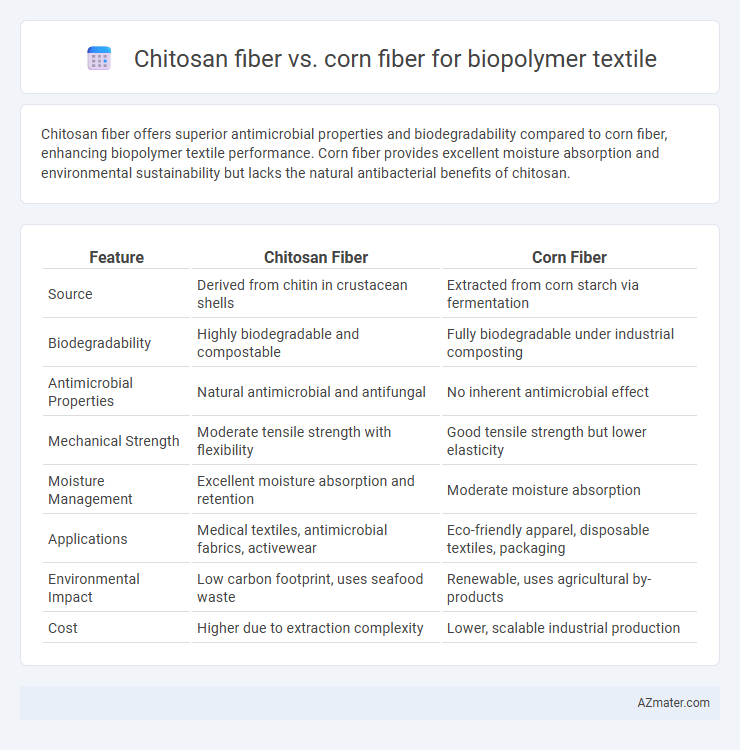Chitosan fiber offers superior antimicrobial properties and biodegradability compared to corn fiber, enhancing biopolymer textile performance. Corn fiber provides excellent moisture absorption and environmental sustainability but lacks the natural antibacterial benefits of chitosan.
Table of Comparison
| Feature | Chitosan Fiber | Corn Fiber |
|---|---|---|
| Source | Derived from chitin in crustacean shells | Extracted from corn starch via fermentation |
| Biodegradability | Highly biodegradable and compostable | Fully biodegradable under industrial composting |
| Antimicrobial Properties | Natural antimicrobial and antifungal | No inherent antimicrobial effect |
| Mechanical Strength | Moderate tensile strength with flexibility | Good tensile strength but lower elasticity |
| Moisture Management | Excellent moisture absorption and retention | Moderate moisture absorption |
| Applications | Medical textiles, antimicrobial fabrics, activewear | Eco-friendly apparel, disposable textiles, packaging |
| Environmental Impact | Low carbon footprint, uses seafood waste | Renewable, uses agricultural by-products |
| Cost | Higher due to extraction complexity | Lower, scalable industrial production |
Introduction to Biopolymer Textiles
Biopolymer textiles derived from chitosan fiber exhibit excellent biodegradability, antimicrobial properties, and high moisture retention, making them ideal for sustainable fashion and medical applications. Corn fiber, extracted from corn husks, offers lightweight, breathable fabric characteristics with good tensile strength and natural biodegradability, supporting eco-friendly textile solutions. Both fibers contribute to reducing reliance on synthetic polymers by providing renewable, biodegradable alternatives in the biopolymer textile industry.
Overview of Chitosan Fiber
Chitosan fiber, derived from chitin found in crustacean shells, is a biodegradable and antimicrobial biopolymer widely used in textile applications. It offers excellent moisture retention, UV protection, and natural antibacterial properties, making it suitable for medical textiles and sustainable fashion. Compared to corn fiber, chitosan fiber exhibits superior bioactivity and environmental benefits due to its renewable marine origin and effective functional properties.
Overview of Corn Fiber
Corn fiber, derived from the byproducts of corn processing, offers a sustainable and biodegradable alternative for biopolymer textiles with excellent moisture-wicking and breathability properties. It is rich in cellulose and hemicellulose, making it suitable for producing eco-friendly fibers that provide comfort and durability in textile applications. Compared to chitosan fiber, corn fiber stands out for its abundant agricultural availability and low environmental impact throughout its production lifecycle.
Production Processes: Chitosan vs. Corn Fiber
Chitosan fiber production involves extracting chitin from crustacean shells, followed by deacetylation and dissolution to form fibers through wet spinning, which makes the process more complex and resource-intensive. Corn fiber production is derived from corn kernel residues, primarily using wet milling and enzymatic treatments to isolate cellulose, enabling mechanical or chemical processes to produce fibers with lower energy consumption. Both fibers have distinct production workflows, where chitosan's extraction depends on seafood waste valorization, while corn fiber leverages agricultural byproducts, impacting scalability and sustainability in biopolymer textile manufacturing.
Physical and Mechanical Properties Comparison
Chitosan fiber exhibits superior tensile strength and elasticity compared to corn fiber, making it more suitable for durable biopolymer textiles. Corn fiber offers better biodegradability and moisture absorption but has lower elongation at break and reduced resistance to mechanical stress. The enhanced mechanical performance of chitosan fiber benefits applications requiring durability and flexibility, while corn fiber's natural breathability favors lightweight, eco-friendly textile products.
Environmental Impact and Sustainability
Chitosan fiber, derived from crustacean shells, offers superior biodegradability and natural antimicrobial properties, significantly reducing environmental pollution compared to corn fiber, which is primarily made from starch and involves intensive agricultural resource consumption. The production of chitosan fiber utilizes waste materials, minimizing landfill contributions and promoting circular economy principles, whereas corn fiber's cultivation demands high water usage and fertilizers, leading to soil degradation and greenhouse gas emissions. Chitosan fiber's lower carbon footprint and renewability make it a more sustainable choice for biopolymer textiles in eco-friendly applications.
Biodegradability and End-of-Life Considerations
Chitosan fiber exhibits superior biodegradability compared to corn fiber due to its natural antimicrobial properties and ability to decompose rapidly in soil and marine environments. Corn fiber, derived from cellulose, also biodegrades effectively but often requires industrial composting conditions for complete breakdown. End-of-life considerations favor chitosan textiles for eco-friendly disposal, reducing microplastic pollution and promoting sustainable textile lifecycles.
Textile Applications and Market Trends
Chitosan fiber exhibits superior antimicrobial properties and biodegradability compared to corn fiber, making it highly suitable for medical textiles, wound dressings, and eco-friendly fashion applications. Corn fiber, derived from cellulose, offers excellent breathability and moisture-wicking qualities, favored in sportswear and casual apparel markets. Market trends indicate growing demand for chitosan-based textiles in healthcare and sustainable luxury sectors, while corn fiber maintains strong growth in affordable, renewable fabric segments.
Challenges and Limitations
Chitosan fiber faces challenges such as low mechanical strength, poor water resistance, and high production costs, limiting its large-scale application in biopolymer textiles. Corn fiber, while biodegradable and renewable, suffers from limited thermal stability and moisture absorption issues, affecting its durability and performance in fabric manufacturing. Both fibers require advanced processing techniques and chemical modifications to overcome these limitations and meet industrial textile standards effectively.
Future Prospects for Chitosan and Corn Fiber Textiles
Chitosan fiber, known for its biodegradability, antimicrobial properties, and biocompatibility, holds significant promise in advanced biopolymer textile applications, especially in medical and hygiene sectors. Corn fiber, derived from cellulose in corn husks, offers a sustainable and cost-effective alternative with excellent moisture-wicking and breathability, making it ideal for eco-friendly fashion and technical fabrics. Future prospects for both fibers emphasize improved functionalization techniques and scalable production methods to meet the growing demand for sustainable and high-performance biopolymer textiles.

Infographic: Chitosan fiber vs Corn fiber for Biopolymer Textile
 azmater.com
azmater.com